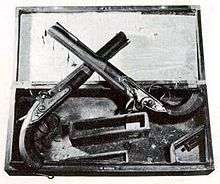Duelling pistol
A duelling pistol is a type of pistol that was manufactured in matching pairs to be used in a duel, when duels were customary. Duelling pistols are often single-shot flintlock or percussion black-powder pistols which fire a lead musket ball. They were made in identical pairs to put both duellists on the same footing. Not all fine pairs of pistols are actual duelling pistols, though they may be called so.
Design
Standard flintlock pistols have a noticeable delay between pulling the trigger and actually firing the bullet. Purpose-built duelling pistols have various improvements to make them more reliable and accurate, such as longer and heavier barrels, spurs on the trigger guards, saw handles, platinum-lined touch-holes and hair triggers. All component parts were manufactured, hand-finished and then adjusted with great care and precision, which made duelling pistols much more costly than standard firearms of the period. Special care was taken when moulding the lead bullets to ensure that there were no voids which would affect accuracy. Pistols were carefully and identically loaded, and each duellist was offered his choice of the indistinguishable loaded pistols. As duels were generally fought at short distances which were paced out, typically 35 to 45 feet (11 to 14 m),[1] between stationary opponents, extreme accuracy was not required.[2]
Duelling pistols had long smoothbore barrels (typically 10 in (250 mm)) and fired large, heavy bullets. Pistols with calibers of 0.45 in (11 mm), 0.52 in (13 mm), 0.58 in (15 mm) or even 0.65 in (17 mm) were common.[3] The bullets loaded in them could weigh half an ounce (214 grains (13.9 g)) in .52 caliber, or more in larger calibers. Bullets were fired with a muzzle velocity of approximately 830 feet per second (250 m/s), which made a .52 caliber bullet about as lethal as a current .45 ACP round - and therefore capable of inflicting very severe wounds. These injuries, coupled with the primitive state of emergency medicine at the time when duels were commonplace, meant that pistol duels frequently resulted in fatalities, either immediately or a few days afterwards. This was the fate of Alexander Pushkin, a highly experienced pistol duellist who had fought 29 duels before being wounded in the stomach by Georges-Charles de Heeckeren d'Anthès on 8 February 1837. Pushkin managed to return fire, slightly wounding d'Anthès, but died two days later.[4]
Most English pistols had smooth bores, though some had scratch rifling, a subtle form of rifling which was difficult to see with the naked eye. Pistols with rifled barrel spin-stabilise the shot when it is fired, resulting in much improved accuracy. As a result, duelling pistols with rifled barrels were considered unsporting by many, although there was no unfairness so long as the pistols were identical.[3]
In continental Europe, the use of smooth-bored pistols was considered cowardly, and rifled pistols were the norm. The short range most duels took place at, combined with the accuracy of rifled pistols meant their use substantially increased the chances of a fatality during a duel.[5] A pair of rifled pistols often included a small hammer as an accessory; they used slightly oversized bullets and a hammer was needed to drive the bullet down the barrel when loading.[6]
Pairs of duelling pistols can be easily confused with holster pistols and traveling pistols. These types are similar to duelling pistols in that they are large, muzzle-loading weapons, that were often expensively made and came in matched, cased pairs with a set of accessories. Traveling pistols, also known as overcoat pistols, were intended for use by travelers to protect themselves from highwaymen and footpads; unlike dueling pistols, they were commonly rifled. Holster pistols were carried in pairs in a leather holster slung across a horse's saddle. Although best suited for military use, they were often owned by civilians. Although their purpose was self-defense, holster pistols were used on occasion to fight duels.[6]
Manufacturers
The use of pistols in duels became popular in Britain, France and America during the mid-eighteenth century. Initially standard holster or travelling pistols were mainly used, but by the end of the century special-purpose duelling pistols were being made by craftsmen in England, France, Germany, Austria and America.[3]
The most famous and innovative manufacturers were London-based companies such as Wogdon & Barton, Durs Egg, Manton, Mortimer, Nock, and Purdey.[3]
Pairs of duelling pistols were often supplied in compartmentalised wooden cases along with a powder flask, rods for cleaning and loading, spare flints, spanners and other tools, and a bullet mould.[2]
Gallery
.jpg)
 Earlier English flintlock duelling pistols made by Wogdon & Barton, used in the fatal Burr-Hamilton duel of 1804
Earlier English flintlock duelling pistols made by Wogdon & Barton, used in the fatal Burr-Hamilton duel of 1804
See also
| Wikimedia Commons has media related to Duelling pistols. |
- Code duello
- Alexander Pushkin (died in 1837, of wounds received in a pistol duel)
- Burr–Hamilton duel
References
- ↑ "www.exetermemories.co.uk/EM/_events/last_duel.php".
- 1 2 Kinard, Jeff (2004). Pistols: An Illustrated History of Their Impact. ABC-CLIO. pp. 29–30. ISBN 978-1-85109-470-7.
- 1 2 3 4 Flayderman, Norm (17 December 2007). Flayderman's Guide to Antique American Firearms and Their Values (9 ed.). Iola, Wisconsin: F+W Media, Inc. pp. 453–454. ISBN 0-89689-455-X.
- ↑ Cohen, Richard (10 June 2010). By the Sword: Gladiators, Musketeers, Samurai Warriors, Swashbucklers and Olympians. New York: Simon and Schuster. pp. 133–134. ISBN 978-1-84983-166-6.
- ↑ Pauly, Roger (1 January 2004). Firearms: The Life Story of a Technology. Greenwood Publishing Group. p. 69. ISBN 978-0-313-32796-4.
- 1 2 Jeff Kinard (2003). Pistols: An Illustrated History of Their Impact. ABC-CLIO. pp. 33–34. ISBN 978-1-85109-470-7.